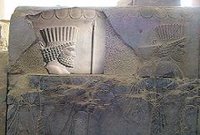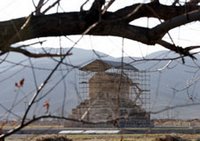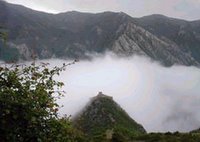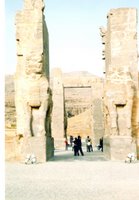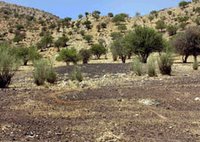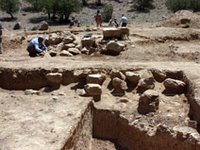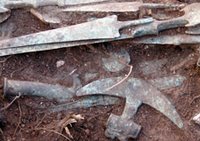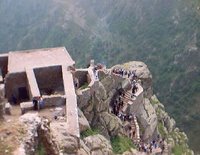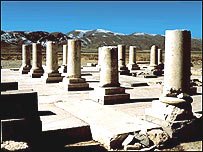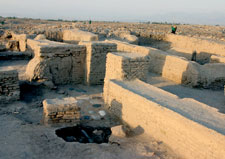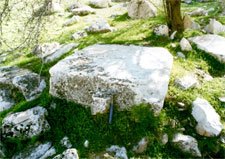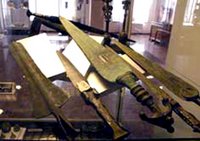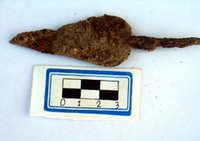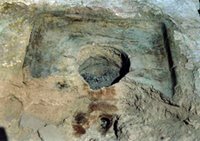Discovery of Wheat Grains Inside a Grave as a Burial Offering in Gohar Tepe

LONDON, May 31, 2006(CAIS) -- Continuation of archaeological excavations in Gohar Tepe led to the discovery of a large amount of wheat grains inside a grave placed in an oblation dish used as a burial gift. Ali Mahforouzi, archaeologist and head of excavation team in Gohar Tepe historical site, believes that discovery of these wheat grains would reveal some aspects of daiet habits of the inhabitants of Gohar Tepe during the Iron Age.
“Initial studies on the wheat grains which were discovered in a dish belonging to the Iron Age show that they are domestic and similar to those already found in Bronze Age layers. This new discovery might change some previous theories about the lifestyle of the people of the Iron Age. While it is believed that the inhabitants of that period had a nomadic life and were not settled in a particular place and earned their livings mostly through animal husbandry, discovery of grown domestic wheat in this area could be used as a proof to claiming that the inhabitants of Gohar Tepe enjoyed permanent settlements during the Iron Age and in addition to animal husbandry they produced grains as well,” said Mahforouzi.
Offering gifts to the dead was a common practice during the ancient times. So far, different kinds of burial methods have been discovered in Gohar Tepe including jar burial, squat burial, fetal burial, etc. Burial gifts were seen in most of the graves regardless of the method used for burial. However, the philosophy behind some of these burial methods as well as the burial gifts is still unknown to archaeologists and required more comprehensive archaeological studies.
Regarding the religious practices of the Gohar Tepe inhabitants during the Iron Age, Mahforouzi said, “What the people of this area practiced as their religion is still a matter of controversy. However, considering the discovery of some clay dishes containing the remains of the bones of some sacrificed animals in the graves, most probably the empty dishes were filled with holly water or other liquids at the time of burial, showing that the people of this region believed in making offerings to the dead” added Mahforouzi.
Based on stratigraphical studies done over the past few decades on the site, Gohar Tepe was an active center in the middle Bronze Age which was still alive during the Iron Age. However, the most ancient cultural layers found in the area belong to the Neolithic period, some 14,000 years ago, which are very similar to those found in other regional states and Central Asia. “The discovered evidence such as the existence of rural life and urbanization, evidence of a flourished economy system, the existence of pottery workshops and forges, stone and clay relics such as the statues of human beings and animals, the remains of plant and animals in the region, and many more evidence found in Gohar Tepe all indicate that this historic site is worth receiving a special attention and support by the people and all the authorities especially the Cultural Heritage and Tourism Organization of the country.
Further excavations in the region would result in a better understanding of the lifestyle of the people who lived in the southern regions of the Caspian Sea,” added Mahforouzi. Gohar Tepe historical site, with a 50 hectare area, is located in eastern parts of Mazandaran province between the cities of Neka and Behshahr, north of Iran. It is one of the most important historical sites of Mazandaran province located near the Caspian Sea which carries the secret of an ancient civilization. It is also believed that Gohar Tepe once enjoyed a complicated urbanization with a history that goes back to some 5000 years ago.
According to the public relations office of the Cultural Heritage and Tourism Office of Mazandaran province, Delavar Bozorgnia, director of this organization is intending to change Gohar Tepe historical site into a museum site with the cooperation of Ali Mahforouzi and other archaeologists, to give tourists the chance to observe closely the remains of the skeletons with their burial gifts and other historical remains discovered in this site and feel themselves in the atmosphere and historical context these objects belonged to. Also a clay oven has been created near the ancient one to make clay objects similar to the ancient ones for tourists to buy as souvenirs.
